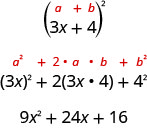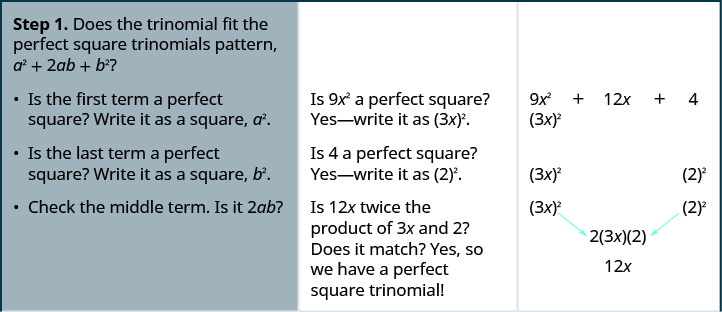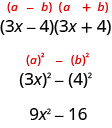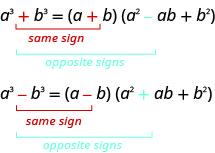45 Factor Special Products
Learning Objectives
By the end of this section, you will be able to:
- Factor perfect square trinomials
- Factor differences of squares
- Factor sums and differences of cubes
Before you get started, take this readiness quiz.
We have seen that some binomials and trinomials result from special products—squaring binomials and multiplying conjugates. If you learn to recognize these kinds of polynomials, you can use the special products patterns to factor them much more quickly.
Factor Perfect Square Trinomials
Some trinomials are perfect squares. They result from multiplying a binomial times itself. We squared a binomial using the Binomial Squares pattern in a previous chapter.

The trinomial ![]() is called a perfect square trinomial. It is the square of the binomial
is called a perfect square trinomial. It is the square of the binomial ![]()
In this chapter, you will start with a perfect square trinomial and factor it into its prime factors.
You could factor this trinomial using the methods described in the last section, since it is of the form ![]() But if you recognize that the first and last terms are squares and the trinomial fits the perfect square trinomials pattern, you will save yourself a lot of work.
But if you recognize that the first and last terms are squares and the trinomial fits the perfect square trinomials pattern, you will save yourself a lot of work.
Here is the pattern—the reverse of the binomial squares pattern.
If a and b are real numbers
To make use of this pattern, you have to recognize that a given trinomial fits it. Check first to see if the leading coefficient is a perfect square, ![]() Next check that the last term is a perfect square,
Next check that the last term is a perfect square, ![]() Then check the middle term—is it the product,
Then check the middle term—is it the product, ![]() If everything checks, you can easily write the factors.
If everything checks, you can easily write the factors.
Factor: ![]()



Factor: ![]()
![]()
Factor: ![]()
![]()
The sign of the middle term determines which pattern we will use. When the middle term is negative, we use the pattern ![]() which factors to
which factors to ![]()
The steps are summarized here.

We’ll work one now where the middle term is negative.
Factor: ![]()
The first and last terms are squares. See if the middle term fits the pattern of a perfect square trinomial. The middle term is negative, so the binomial square would be ![]()
 |
|
| Are the first and last terms perfect squares? |  |
| Check the middle term. |  |
| Does it match |
 |
| Write as the square of a binomial. |  |
| Check by multiplying:
|
Factor: ![]()
![]()
Factor: ![]()
![]()
The next example will be a perfect square trinomial with two variables.
Factor: ![]()
 |
|
| Test each term to verify the pattern. |  |
| Factor. |  |
| Check by multiplying.
|
Factor: ![]()
![]()
Factor: ![]()
![]()
Remember the first step in factoring is to look for a greatest common factor. Perfect square trinomials may have a GCF in all three terms and it should be factored out first. And, sometimes, once the GCF has been factored, you will recognize a perfect square trinomial.
Factor: ![]()
 |
|
| Is there a GCF? Yes, |
 |
| Is this a perfect square trinomial? | |
| Verify the pattern. |  |
| Factor. |  |
Remember: Keep the factor 4y in the final product.
Check:
![Rendered by QuickLaTeX.com \phantom{\rule{4em}{0ex}}\begin{array}{c}\hfill 4y{\left(5x-2\right)}^{2}\hfill \\ \hfill 4y\left[{\left(5x\right)}^{2}-2·5x·2+{2}^{2}\right]\hfill \\ \hfill 4y\left(25{x}^{2}-20x+4\right)\hfill \\ \hfill 100{x}^{2}y-80xy+16y✓\hfill \end{array}](https://pressbooks.bccampus.ca/jkdcintermediatealgebracloned/wp-content/ql-cache/quicklatex.com-ac26bb8552a61652512c7e4929a7f468_l3.png)
Factor: ![]()
![]()
Factor: ![]()
![]()
Factor Differences of Squares
The other special product you saw in the previous chapter was the Product of Conjugates pattern. You used this to multiply two binomials that were conjugates. Here’s an example:

A difference of squares factors to a product of conjugates.
If a and b are real numbers,

Remember, “difference” refers to subtraction. So, to use this pattern you must make sure you have a binomial in which two squares are being subtracted.
Factor: ![]()




Factor: ![]()
![]()
Factor: ![]()
![]()
*** QuickLaTeX cannot compile formula:
\begin{array}{ccccc}\mathbf{\text{Step 1.}}\hfill & \text{Does the binomial fit the pattern?}\hfill & & & \hfill \phantom{\rule{4em}{0ex}}{a}^{2}-{b}^{2}\hfill \\ & \text{Is this a difference?}\hfill & & & \hfill \phantom{\rule{4em}{0ex}}\text{____}-\text{____}\hfill \\ & \text{Are the first and last terms perfect squares?}\hfill & & & \\ \mathbf{\text{Step 2.}}\hfill & \text{Write them as squares.}\hfill & & & \hfill \phantom{\rule{4em}{0ex}}{\left(a\right)}^{2}-{\left(b\right)}^{2}\hfill \\ \mathbf{\text{Step 3.}}\hfill & \text{Write the product of conjugates.}\hfill & & & \hfill \phantom{\rule{4em}{0ex}}\left(a-b\right)\left(a+b\right)\hfill \\ \mathbf{\text{Step 4.}}\hfill & \text{Check by multiplying.}\hfill & & & \end{array}
*** Error message:
Missing $ inserted.
leading text: ...\hfill \phantom{\rule{4em}{0ex}}\text{____}
Missing { inserted.
leading text: ...\hfill \phantom{\rule{4em}{0ex}}\text{____}
Missing { inserted.
leading text: ...\hfill \phantom{\rule{4em}{0ex}}\text{____}
Missing { inserted.
leading text: ...\hfill \phantom{\rule{4em}{0ex}}\text{____}
Missing { inserted.
leading text: ...\hfill \phantom{\rule{4em}{0ex}}\text{____}
Missing $ inserted.
leading text: ...\hfill \phantom{\rule{4em}{0ex}}\text{____}
Missing { inserted.
leading text: ...\hfill \phantom{\rule{4em}{0ex}}\text{____}
Missing { inserted.
leading text: ...\hfill \phantom{\rule{4em}{0ex}}\text{____}
Missing { inserted.
leading text: ...\hfill \phantom{\rule{4em}{0ex}}\text{____}
Missing { inserted.
leading text: ...\hfill \phantom{\rule{4em}{0ex}}\text{____}
It is important to remember that sums of squares do not factor into a product of binomials. There are no binomial factors that multiply together to get a sum of squares. After removing any GCF, the expression ![]() is prime!
is prime!
The next example shows variables in both terms.
Factor: ![]()

Factor: ![]()
![]()
Factor: ![]()
![]()
As always, you should look for a common factor first whenever you have an expression to factor. Sometimes a common factor may “disguise” the difference of squares and you won’t recognize the perfect squares until you factor the GCF.
Also, to completely factor the binomial in the next example, we’ll factor a difference of squares twice!
Factor: ![]()

The last factor, the sum of squares, cannot be factored.

Factor: ![]()
![]()
Factor: ![]()
![]()
The next example has a polynomial with 4 terms. So far, when this occurred we grouped the terms in twos and factored from there. Here we will notice that the first three terms form a perfect square trinomial.
Factor: ![]()
Notice that the first three terms form a perfect square trinomial.
 |
|
| Factor by grouping the first three terms. |  |
| Use the perfect square trinomial pattern. |  |
| Is this a difference of squares? Yes. | |
| Yes—write them as squares. |  |
| Factor as the product of conjugates. |  |
 |
You may want to rewrite the solution as ![]()
Factor: ![]()
![]()
Factor: ![]()
![]()
Factor Sums and Differences of Cubes
There is another special pattern for factoring, one that we did not use when we multiplied polynomials. This is the pattern for the sum and difference of cubes. We will write these formulas first and then check them by multiplication.
We’ll check the first pattern and leave the second to you.
 |
|
| Distribute. |  |
| Multiply. |  |
| Combine like terms. |  |
The two patterns look very similar, don’t they? But notice the signs in the factors. The sign of the binomial factor matches the sign in the original binomial. And the sign of the middle term of the trinomial factor is the opposite of the sign in the original binomial. If you recognize the pattern of the signs, it may help you memorize the patterns.

The trinomial factor in the sum and difference of cubes pattern cannot be factored.
It be very helpful if you learn to recognize the cubes of the integers from 1 to 10, just like you have learned to recognize squares. We have listed the cubes of the integers from 1 to 10 in (Figure).
| n | 1 | 2 | 3 | 4 | 5 | 6 | 7 | 8 | 9 | 10 |
|---|---|---|---|---|---|---|---|---|---|---|
| 1 | 8 | 27 | 64 | 125 | 216 | 343 | 512 | 729 | 1000 |
Factor: ![]()





Factor: ![]()
![]()
Factor: ![]()
![]()
- Does the binomial fit the sum or difference of cubes pattern?
Is it a sum or difference?
Are the first and last terms perfect cubes?
- Write them as cubes.
- Use either the sum or difference of cubes pattern.
- Simplify inside the parentheses.
- Check by multiplying the factors.
Factor: ![]()
 |
|
| This binomial is a difference. The first and last
terms are perfect cubes. |
|
| Write the terms as cubes. |  |
| Use the difference of cubes pattern. |  |
| Simplify. |  |
| Check by multiplying. | We’ll leave the check to you. |
Factor: ![]()
![]()
Factor: ![]()
![]()
In the next example, we first factor out the GCF. Then we can recognize the sum of cubes.
Factor: ![]()
 |
|
| Factor the common factor. |  |
| This binomial is a sum The first and last
terms are perfect cubes. |
|
| Write the terms as cubes. |  |
| Use the sum of cubes pattern. |  |
| Simplify. |  |
Check:
To check, you may find it easier to multiply the sum of cubes factors first, then multiply that product by ![]() We’ll leave the multiplication for you.
We’ll leave the multiplication for you.
Factor: ![]()
![]()
Factor: ![]()
![]()
The first term in the next example is a binomial cubed.
Factor: ![]()
 |
|
| This binomial is a difference. The first and
last terms are perfect cubes. |
|
| Write the terms as cubes. |  |
| Use the difference of cubes pattern. |  |
| Simplify. |  |
 |
|
| Check by multiplying. | We’ll leave the check to you. |
Factor: ![]()
![]()
Factor: ![]()
![]()
Access this online resource for additional instruction and practice with factoring special products.
Key Concepts
- Perfect Square Trinomials Pattern: If a and b are real numbers,

- How to factor perfect square trinomials.

- Difference of Squares Pattern: If
 are real numbers,
are real numbers,

- How to factor differences of squares.
*** QuickLaTeX cannot compile formula: \begin{array}{ccccc}\text{Step 1.}\hfill & \text{Does the binomial fit the pattern?}\hfill & & & \hfill \phantom{\rule{4em}{0ex}}{a}^{2}-{b}^{2}\hfill \\ & \text{Is this a difference?}\hfill & & & \hfill \phantom{\rule{4em}{0ex}}\text{____}-\text{____}\hfill \\ & \text{Are the first and last terms perfect squares?}\hfill & & & \\ \text{Step 2.}\hfill & \text{Write them as squares.}\hfill & & & \hfill \phantom{\rule{4em}{0ex}}{\left(a\right)}^{2}-{\left(b\right)}^{2}\hfill \\ \text{Step 3.}\hfill & \text{Write the product of conjugates.}\hfill & & & \hfill \phantom{\rule{4em}{0ex}}\left(a-b\right)\left(a+b\right)\hfill \\ \text{Step 4.}\hfill & \text{Check by multiplying.}\hfill & & & \end{array} *** Error message: Missing $ inserted. leading text: ...\hfill \phantom{\rule{4em}{0ex}}\text{____} Missing { inserted. leading text: ...\hfill \phantom{\rule{4em}{0ex}}\text{____} Missing { inserted. leading text: ...\hfill \phantom{\rule{4em}{0ex}}\text{____} Missing { inserted. leading text: ...\hfill \phantom{\rule{4em}{0ex}}\text{____} Missing { inserted. leading text: ...\hfill \phantom{\rule{4em}{0ex}}\text{____} Missing $ inserted. leading text: ...\hfill \phantom{\rule{4em}{0ex}}\text{____} Missing { inserted. leading text: ...\hfill \phantom{\rule{4em}{0ex}}\text{____} Missing { inserted. leading text: ...\hfill \phantom{\rule{4em}{0ex}}\text{____} Missing { inserted. leading text: ...\hfill \phantom{\rule{4em}{0ex}}\text{____} Missing { inserted. leading text: ...\hfill \phantom{\rule{4em}{0ex}}\text{____} - Sum and Difference of Cubes Pattern

- How to factor the sum or difference of cubes.
- Does the binomial fit the sum or difference of cubes pattern?
Is it a sum or difference?
Are the first and last terms perfect cubes?
- Write them as cubes.
- Use either the sum or difference of cubes pattern.
- Simplify inside the parentheses
- Check by multiplying the factors.
- Does the binomial fit the sum or difference of cubes pattern?
Practice Makes Perfect
Factor Perfect Square Trinomials
In the following exercises, factor completely using the perfect square trinomials pattern.
![]()
![]()
![]()
![]()
![]()
![]()
![]()
![]()
![]()
![]()
![]()
![]()
![]()
![]()
![]()
![]()
![]()
![]()
![]()
![]()
![]()
![]()
![]()
![]()
Factor Differences of Squares
In the following exercises, factor completely using the difference of squares pattern, if possible.
![]()
![]()
![]()
![]()
![]()
![]()
![]()
![]()
![]()
![]()
![]()
![]()
![]()
![]()
![]()
![]()
![]()
![]()
![]()
![]()
![]()
![]()
![]()
![]()
![]()
![]()
![]()
![]()
![]()
![]()
Factor Sums and Differences of Cubes
In the following exercises, factor completely using the sums and differences of cubes pattern, if possible.
![]()
![]()
![]()
![]()
![]()
![]()
![]()
![]()
![]()
![]()
![]()
![]()
![]()
![]()
![]()
![]()
![]()
![]()
![]()
![]()
![]()
![]()
![]()
![]()
![]()
![]()
![]()
Mixed Practice
In the following exercises, factor completely.
![]()
![]()
![]()
![]()
![]()
![]()
![]()
![]()
![]()
![]()
![]()
![]()
![]()
![]()
![]()
![]()
![]()
![]()
![]()
![]()
![]()
![]()
![]()
![]()
Writing Exercises
Why was it important to practice using the binomial squares pattern in the chapter on multiplying polynomials?
Answers will vary.
How do you recognize the binomial squares pattern?
Explain why ![]() Use algebra, words, or pictures.
Use algebra, words, or pictures.
Answers will vary.
Maribel factored ![]() as
as ![]() Was she right or wrong? How do you know?
Was she right or wrong? How do you know?
Self Check
ⓐ After completing the exercises, use this checklist to evaluate your mastery of the objectives of this section.

ⓑ What does this checklist tell you about your mastery of this section? What steps will you take to improve?



